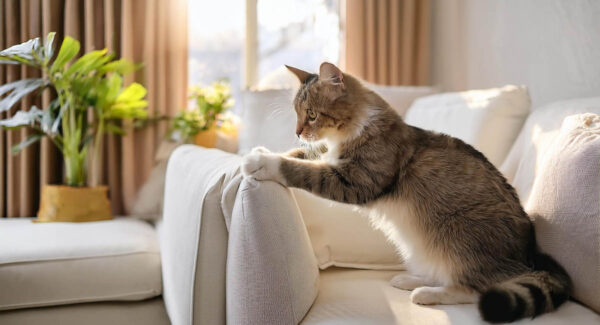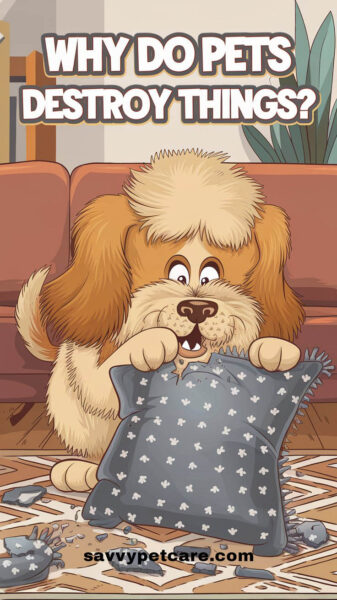Understanding Why Pets Destroy Things
As a foster parent for rescue cats, I’ve seen my fair share of destruction. From shredded furniture to chewed-up shoes, pets can sometimes seem like little tornadoes of chaos. But here’s the thing: these behaviors aren’t usually a sign of “bad” pets. In fact, there’s often a deeper reason behind why pets destroy things. Whether it’s boredom, anxiety, or natural instincts, pets can act out in ways that leave us frustrated and confused.
I remember one of my first foster cats, a little ball of energy who loved to claw at anything that wasn’t nailed down. At first, because she was so much more destructive than some, I was frustrated, thinking she was just being naughty. But as I learned more about her needs and behaviors, I realized she wasn’t being mischievous—she was just trying to communicate. Like many pets, she was craving attention, stimulation, and a safe space to express herself.
In this post, we’ll take a closer look at why pets destroy things, what drives them to act out, and how you can help prevent it. With a little understanding, patience, and the right strategies, you can turn destructive behavior into a thing of the past.
Why Pets Destroy Things
As pet owners, we often ask ourselves, “Why do they do this?” Destructive behavior can be frustrating, but understanding the reasons behind it is the first step toward solving the problem. Here are some of the most common reasons why pets destroy things:
1. Natural Instincts
Many pets, especially dogs and cats, are driven by instincts to explore their environment. For dogs, chewing is a natural behavior that starts as a way to relieve teething pain during puppyhood. Even as they get older, they may chew out of boredom or to satisfy a need for mental stimulation. Cats, on the other hand, may scratch furniture or other objects to mark their territory or remove the outer sheath of their claws.
- “Destructive behavior doesn’t always mean your pet is being naughty. It’s often just part of their natural instincts.”
2. Boredom and Lack of Stimulation
Pets need physical and mental stimulation to stay happy and healthy. Without it, they can become bored, which often leads to destructive behavior. Dogs might chew shoes or furniture, while cats may scratch things or try to climb places they shouldn’t. A friend once sent me photos of his patio furniture completely destroyed by his Rottweiler that had been left at home alone! If you’ve noticed your pet destroying items when you’re away or when there’s a lack of activity, boredom might be the culprit.
- “A bored pet is a mischievous pet. Providing regular mental and physical activities is one of the best ways to keep destructive behavior at bay.”
3. Anxiety or Stress
Just like us, pets can experience stress and anxiety. Changes in their environment, such as a move to a new home, the arrival of a new pet, or even loud noises, can cause them to act out. Dogs, in particular, might chew on furniture or doors as a way to self-soothe when left alone (separation anxiety). Cats may over-groom or engage in other compulsive behaviors if they feel stressed.
- “Stressful situations, whether it’s being left alone or adjusting to a new home, can trigger behaviors like chewing or scratching.”
4. Lack of Training or Boundaries
Sometimes, pets don’t know what’s acceptable and what isn’t. Without proper training or boundaries, pets may simply act out because they haven’t been taught the right way to behave. This is especially common in young pets who are still learning how to interact with their environment.
- “Training your pet is key. They need to understand which behaviors are acceptable and which ones aren’t.”
5. Health Issues
If your pet’s destructive behavior seems unusual or comes on suddenly, it’s always a good idea to rule out any health issues. Dental problems, for example, can lead to excessive chewing in dogs, while skin conditions or allergies might cause a cat to scratch excessively. If your pet’s behavior is out of character, a visit to the vet might uncover an underlying medical issue that needs attention.
- “Before jumping to conclusions, it’s worth checking if health issues might be contributing to your pet’s behavior.”
Solutions to Prevent Destructive Behavior
Now that we’ve explored the reasons behind destructive behavior, let’s talk about how to address it. The good news is that most destructive habits can be corrected with patience, consistency, and the right strategies. Here are some solutions to help you prevent your pet from destroying things:
1. Provide Enrichment
Pets need mental stimulation just as much as physical exercise. Without it, they’ll find their own ways to stay entertained—and sometimes that means destroying your favorite chair or shoes! Enriching your pet’s environment can help redirect their energy into positive outlets.
- Interactive Toys: Treat-dispensing toys and puzzle feeders keep pets mentally engaged and reward them for problem-solving.
- Cat Trees and Scratching Posts: For cats, providing vertical space and designated scratching areas can save your furniture. Check out my post If My Cats Had a Bucket List for more ideas.
- Chew Toys: For dogs, durable chew toys like rubber bones or puzzle toys can keep them occupied and away from your personal items.
“A tired pet is a happy pet! Keep their minds and bodies engaged with plenty of enrichment activities.”
2. Exercise and Playtime
Daily physical activity is key for pets of all ages. Dogs, in particular, need regular walks, runs, or play sessions to burn off excess energy. Cats, too, benefit from active play—whether it’s chasing a feather toy or exploring new spaces. When pets don’t get enough exercise, they may resort to destructive behaviors to release their pent-up energy.
- For Dogs: Take them on regular walks, runs, or play fetch in the yard. Interactive games like tug-of-war can also be a great way to bond and burn energy.
- For Cats: Use laser pointers, feather wands, or interactive toys to encourage them to exercise and engage their hunting instincts.
“Don’t underestimate the power of playtime. Regular activity is one of the best ways to prevent destructive behavior.”
3. Training and Positive Reinforcement
Training your pet is crucial in preventing destructive behavior. Teaching them what is acceptable and rewarding positive behaviors helps them understand your expectations. Training also strengthens your bond with your pet, which can reduce anxiety and frustration.
- Redirect Destructive Behavior: If your pet starts chewing or scratching something they shouldn’t, gently redirect them to a more appropriate toy.
- Positive Reinforcement: Reward your pet with treats, praise, and affection when they exhibit good behavior. This helps reinforce what they should be doing.
- Basic Commands: Teach your pet simple commands like “leave it” or “drop it” to prevent them from getting into trouble.
“Consistency is key! The more you train your pet, the more they’ll learn what’s acceptable.”
4. Create a Pet-Friendly Environment
Make your home as pet-friendly as possible by creating spaces for them to explore, relax, and play. Here are a few tips to help:
- Designated Chew Areas for Dogs: If your dog loves to chew, make sure they have access to safe chew toys and designate certain areas for them to indulge in this behavior.
- Scratching Posts for Cats: Place scratching posts or pads around your home, particularly near furniture your cat may be tempted to scratch.
- Calm Spaces: If your pet seems anxious or overwhelmed, create a quiet, calm space where they can retreat and relax.
“A little planning goes a long way. By making your home pet-friendly, you can reduce the temptation for destructive behavior.”
5. Address Underlying Stress or Anxiety
If your pet’s destructive behavior is related to anxiety, it’s important to address the root cause. Pets with separation anxiety, for example, may chew or scratch when left alone. There are several ways to help alleviate stress and anxiety in your pet:
- Calming Products: Products like anxiety wraps, pheromone diffusers, or calming sprays can help reduce stress in pets.
- Gradual Desensitization: For pets with separation anxiety, start by leaving them alone for short periods and gradually increase the duration to help them adjust.
- Consult a Professional: If your pet’s anxiety is severe, consider seeking help from a professional trainer or behaviorist who can provide tailored strategies.
“Addressing your pet’s anxiety early on can prevent long-term destructive habits and help them feel more secure.”
When to Seek Professional Help
While most destructive behaviors can be corrected with time and consistent effort, there are situations where professional help may be needed. If your pet’s behavior is persistent or seems to be getting worse, it’s important to consider seeking expert advice.
1. Unresolved Destructive Behavior
If your pet continues to destroy things despite your best efforts at training and providing stimulation, it may be time to seek help from a professional. Sometimes, destructive behavior is a sign of an underlying issue that requires more specialized intervention.
2. Severe Anxiety or Aggression
Pets that exhibit severe anxiety (such as excessive separation anxiety) or aggression might need professional assistance. A trainer or behaviorist can create a plan tailored to your pet’s needs, helping to reduce anxiety and redirect destructive behaviors.
3. Health Concerns
If you’ve tried everything and your pet’s behavior continues to be problematic, it’s a good idea to consult with your vet. Sometimes destructive behavior is linked to health issues like dental pain, allergies, or even neurological conditions. A vet can perform a thorough examination and recommend treatment options.
4. Consulting a Professional Trainer or Behaviorist
If your pet’s destructive behavior is affecting their quality of life or your home environment, working with a trainer or behaviorist can be an effective solution. They can provide personalized training plans and guidance to help your pet overcome their habits.
“Remember, you’re not alone in this. Professionals are trained to help you and your pet through difficult behaviors, and seeking help can often make a world of difference.”
Wrapping It Up: Be Patient, Be Consistent
Destructive behavior in pets can be challenging, but it’s important to remember that it’s rarely personal. Most pets aren’t trying to be naughty—they’re simply expressing a need or coping with something in their environment. Whether it’s boredom, anxiety, or a lack of training, understanding the root cause is the first step toward solving the problem.
The good news is that with patience, consistency, and the right approach, you can help your pet overcome destructive habits and create a harmonious home. By providing enrichment, exercising your pet, setting boundaries, and addressing any underlying issues, you can guide your pet toward more positive behaviors.
If you find yourself struggling, don’t hesitate to reach out to a professional for guidance. With the right support, you and your pet can work through these challenges together.
So, remember: pets don’t destroy things out of spite—they’re trying to tell us something. Let’s listen, and together, we can create a happier, healthier environment for everyone.
Has your pet ever exhibited destructive behavior? Share your experiences and tips in the comments below! And if you’re looking for ways to keep your pet entertained and prevent boredom, don’t forget to check out our Top 10 Toys to Keep Your Pet Busy—they’ll thank you for it!



























